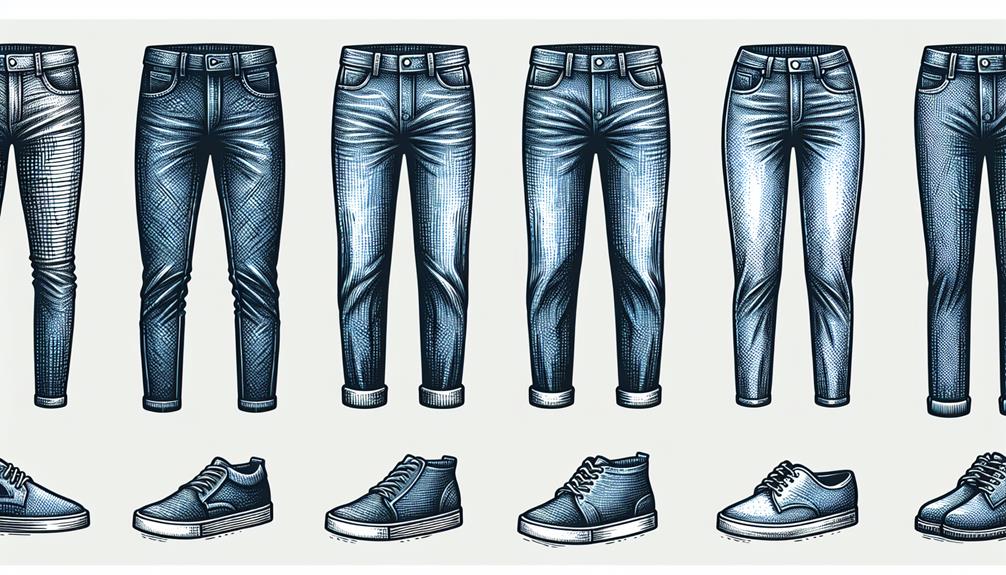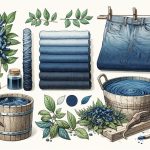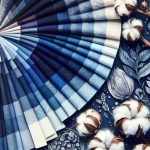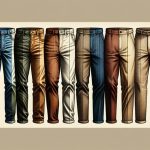I've always been fascinated by how denim has evolved from its workwear origins to a staple in everyone's wardrobe. What's interesting is figuring out what actually qualifies as denim. Sure, we all know the classic blue jeans, but with today's fashion, there's so much more on the table. From the traditional indigo dye to the specific twill weave, the characteristics that define denim are both broad and nuanced. But here's the kicker – as we explore the vast world of denim, we'll uncover some surprises that challenge our conventional understanding of what denim pants really are. So, let's dive into this together, shall we?
Table of Contents
Key Takeaways
- Pants made from sturdy cotton twill material with a unique twill weave pattern are considered denim.
- Denim pants often feature the classic blue color from the indigo dyeing process, though they come in various colors.
- Styles such as skinny, straight, bootcut, boyfriend, and wide-leg all qualify as denim when made with the characteristic fabric.
- Denim pants can include design elements like specific pocket designs, stitching patterns, and hardware details.
- Varieties of denim pants undergo treatments like stone-washing or distressing, adding character while maintaining their denim identity.
Defining Denim Fabric
Over the years, denim has become a go-to fabric, known for its toughness and versatility. At its core, denim's a sturdy cotton twill material, making it a reliable choice for a wide range of clothing items beyond just the iconic jeans. What really sets denim apart is its unique twill weave pattern. This technique involves weaving the cotton threads in a way that creates its distinctive diagonal ribbing, adding to its durability and aesthetic appeal.
The indigo dyeing process is another hallmark of denim, giving it that classic blue color we all know and love. This isn't just about looks, though; the way denim fades over time, especially with wear and washing, adds character to each piece, making it uniquely yours.
In terms of versatility, denim's second to none. It's been adopted in various styles and designs, moving beyond traditional jeans to jackets, skirts, and more. Its timeless appeal in the fashion industry speaks volumes about its adaptability and the endless possibilities it offers for personal expression. Whether you're going for a casual look or something more dressed up, denim's got you covered.
Traditional Jeans: The Denim Icon
Alright, let's get into the nitty-gritty of traditional jeans, the undeniable denim icon that's been around since the 1870s.
I'm excited to explore their rich history, what makes denim such a tough yet stylish fabric, and the variety of styles and fits that have emerged over the years.
It's fascinating how these pants evolved from miner's gear to a wardrobe essential across the globe.
History of Jeans
I've always been fascinated by how jeans, invented in the 1870s for rugged work, became an undeniable fashion staple today. The history of jeans kicks off with Jacob Davis and Levi Strauss, who essentially birthed denim jeans. Originally, these pants were the go-to for miners and cowboys, thanks to their durability.
What's cool is how Levi Strauss took things up a notch by patenting copper rivets in 1873, making jeans even tougher. Fast forward to the 1950s, and jeans are suddenly the uniform of the rebel. This shift from pure workwear to a fashion icon is something else. It's a testament to the jeans' versatility and their unique place in our closets and culture.
Denim Fabric Characteristics
Let's dive into what makes denim such a standout fabric in the world of jeans.
| Feature | Detail | Impact |
|---|---|---|
| Material | Heavy cotton twill | Offers unmatched durability and strength |
| Weave | Indigo, gray, or mottled white yarn | Unique look that molds to your body |
| Evolution | Reinforced with copper rivets | Perfect for labor, now a fashion statement |
| Invention | Patented in 1873 by Jacob Davis and Levi Strauss | Cemented its iconic status |
| Adaptability | Molds to the wearer | Creates a unique, personal fit over time |
Denim's not just any fabric; it's the backbone of traditional jeans. Its cotton twill construction offers durability that's hard to beat, and over time, it shapes itself to you, making each pair uniquely yours.
Styles and Fits
After exploring the unique characteristics that set denim apart, I'll now take a closer look at the various styles and fits that have made traditional jeans an iconic wardrobe staple.
From skinny to straight, and bootcut to boyfriend, these types of trousers cater to different preferences and body shapes, highlighting the difference in fashion choices. The fits like tapered, flared, wide-leg, and cropped offer a broad spectrum for consumers to find their perfect match.
Not to mention, the pocket designs, stitching patterns, and hardware details add that extra flair. And let's not forget about the distressed details and the range of washes and finishes available. It's these styles and fits that keep traditional jeans at the forefront of fashion, always evolving yet timeless.
Characteristics of Denim
So, let's talk about what makes denim, well, denim.
We'll cover its makeup, how it's woven, and the different types you can find out there.
It's all about getting to the heart of why this fabric's been a go-to for so long.
Denim Fabric Composition
Denim's unique blend of strength and style comes from its typical 100% cotton composition, often jazzed up with a bit of stretch for extra comfort. We're talking about a cotton twill fabric here, folks. It's the backbone of those jeans we can't live without.
The indigo dye? That's what gives denim its classic blue look. But let's not forget about the stretch materials like elastane thrown into the mix. These add a whole new level of comfort and flexibility.
Then there's raw denim – this bad boy hasn't been treated or washed, making it a canvas for your life. It ages with you, getting those cool fades and distress marks. Its strength and durability? Unmatched.
Denim isn't just fabric; it's a lifestyle.
Weaving Process Explained
Let's dive into how denim gets its tough yet stylish character through its weaving process. The secret? A twill weave pattern. This isn't just any old way of crossing threads. We're talking about a specific interlacing of warp and weft yarns that forms denim's backbone.
By following a 3/1 or 2/1 twill weave, this method doesn't just add texture; it amps up the durability. Imagine the warp yarns standing tall while the weft sneaks under them at precise intervals. This dance results in diagonal ribbing that's not just for looks.
It makes denim both strong and durable, ready to face whatever you throw at it while keeping that smooth finish on one side. That's the magic of denim's weave, folks.
Denim Types Overview
Exploring the world of denim, we find a range of types each boasting unique characteristics that cater to different tastes and needs. The core of denim fabric is its sturdy cotton twill foundation, known for unparalleled durability. But not all denim clings to tradition; some blend in a bit of stretch material, offering that much-needed flexibility without sacrificing the personalized fit denim is celebrated for.
- Durability: The heart of denim's appeal; its ruggedness is unmatched, perfect for those who value longevity in their wardrobe.
- Comfort meets flexibility: A dash of stretch material ensures your denim moves with you, blending comfort with a fit that feels tailor-made.
- Personalized Fit: Over time, denim molds to your body, offering a fit that's uniquely yours, making each piece a personal statement.
Varieties of Denim Pants
I'm diving into the different styles of denim pants available, from skinny to wide-leg, each offering its own vibe and fit.
We're not just talking about a simple pair of jeans here; the world of denim is vast and varied, catering to just about any preference or body type you can think of. You've got your classic skinny jeans, perfect for a sleek, close-fitted look. Then there's the bootcut and straight-leg styles, which offer a bit more room and a nod to traditional denim aesthetics. For those who love a relaxed feel, boyfriend and wide-leg jeans are your go-tos, providing comfort without skimping on style.
But let's not overlook the details that make each pair unique. Distressed denim brings that rugged, lived-in appeal with its fading, whiskering, and fraying. Meanwhile, selvedge denim ups the ante with its premium, durable edges, appealing to the connoisseurs among us. And let's talk about comfort – stretch materials like elastane have revolutionized denim, making even the skinniest jeans a joy to wear.
With a myriad of washes and finishes from raw to stone-washed, denim pants styles are as diverse as they're fashionable.
The Weaving Process
Delving into how denim gets its unique texture and durability, the weaving process plays a crucial role. At its heart, the magic happens with the twill weave pattern. This isn't your average fabric making. It's what gives denim that iconic diagonal ribbing, setting it apart visually and functionally from other materials.
The choice of colors in the weaving process, specifically blue or indigo for the warp threads and white for the weft, isn't just about aesthetics. It's a deliberate choice that contributes to the classic look we all know and love in our jeans. And let's not overlook the specialized looms required for this task. These aren't your run-of-the-mill machines; they're engineered to handle the hefty cotton yarns denim demands, ensuring each pair of jeans can stand up to wear and tear.
- Twill weave: Not just a pattern but the backbone of denim's durability and distinctive texture.
- Blue and white threads: A timeless combo that gives denim its signature appearance.
- Specialized looms: The unsung heroes that turn tough cotton yarns into the denim we depend on.
Understanding the weaving process sheds light on why denim feels and lasts like it does. It's a blend of tradition, technology, and choice materials, all woven together to create the fabric of our everyday lives.
Color and Dye Techniques
So, we've talked about how denim gets woven, but what makes it really stand out is its color and how it's dyed.
Starting off, everyone knows the classic blue denim, thanks to traditional indigo. But nowadays, techniques have evolved, and we're seeing denim in a whole palette of colors and some pretty cool dye effects that go way beyond the basics.
Traditional Indigo Blue Denim
Let's dive into the world of traditional indigo blue denim, where the color and dye techniques set the stage for timeless fashion. Crafted from natural indigo dye derived from the indigo plant, this method isn't just about dunking fabric into a dye bath. It's an art that involves multiple dips to achieve that deep, iconic color we all know and love. The beauty of traditional indigo dye lies not just in the color itself but in how it ages. With each wear and wash, denim transforms, showcasing unique shades and a fading pattern that's as personal as a signature.
Traditional indigo dye ensures each piece of denim has a story, evolving with aging and wear. The iconic color and unique fading pattern create a bond between the garment and its owner. Unique shades introduced by different brands add depth to the classic denim narrative, inviting connoisseurs to explore beyond the surface.
Innovative Dyeing Methods
Moving beyond traditional methods, the denim industry is now embracing innovative dyeing techniques that are both eco-friendly and visually stunning. Techniques like laser washing and ozone fading are revolutionizing denim production. Laser technology isn't just cool; it allows for intricate patterns and designs without dunking jeans in dye. It's a game changer, especially when I'm all about reducing waste and avoiding harsh chemicals.
On the flip side, ozone fading slashes water usage and ditches those nasty chemicals, making the whole process kinder to our planet.
Then there's the shift towards eco-friendly dye processes. Using organic and non-toxic dyes, this approach drastically lowers the environmental impact. It's not just about looking good in denim; it's about feeling good about how it's made.
Beyond Blue: Color Expansions
Exploring the world of denim doesn't stop at the classic blue; it's a colorful journey through innovative dye techniques that introduce a spectrum of shades from subtle greys to vibrant tie-dyes. Black denim, grey denim, white denim, and colored denim options are just the beginning. The techniques used, like sulfur dyeing and reactive dyeing, open up endless possibilities.
- Sulfur and reactive dyeing bring out deep, rich colors, offering durability and variety.
- Acid wash creates a uniquely worn look, making each piece distinct.
- Overdyeing and tie-dye techniques allow for creativity to shine, producing denim that stands out in a sea of traditional blues.
Mastering these dyeing techniques means unlocking a world where denim isn't just about utility but also about expression and innovation.
Denim Treatments Explained
Diving into denim treatments, we'll see how methods like stone-washing and enzyme wash give our jeans that perfectly lived-in look. Stone-washing, for instance, involves rolling denim with pumice stones. This doesn't just fade the color but also softens the fabric, making your pair feel like an old favorite from the first wear. Enzyme wash takes a slightly different tack. It uses enzymes to distress the denim, which not only softens the fabric but does it in a way that's more environmentally friendly than using harsh chemicals.
Then there's acid wash, a throwback from the '80s that's found its way back into our closets. This technique creates a stark contrasted, bleached effect that's nothing short of eye-catching. And let's not forget about distressing techniques. We're talking about sanding, ripping, and fraying to add character and edge to our denim. Each method, from subtle whiskering around the thighs and crotch to create that naturally worn look, to more aggressive treatments, plays a part in giving denim its personality. Mastering these treatments means we can pick jeans that truly express our style, making each pair uniquely ours.
Understanding Denim Weights
After covering how denim gets its unique look through various treatments, let's focus on how the weight of denim plays a significant role in its feel and function. When I'm picking out denim, I always consider denim weights because they tell me a lot about how the fabric will wear over time. Whether it's the raw material for my next DIY project or just choosing a new pair of jeans, understanding these weights is key.
- Lighter denim (4-8 oz) is what I reach for when I want something soft and comfy, especially for casual shirts that drape nicely.
- Heavier denim (13-15 oz) is my go-to for durable trousers that can take a beating. It's stiffer, sure, but it means business when it comes to longevity.
The weight affects not just the feel but also the drape and durability of denim as well, making it crucial for picking the right denim for the right occasion.
Denim Fitting Guide
Finding the perfect fit for denim pants involves more than just grabbing a pair off the shelf; it's about understanding the nuances of waist, inseam, rise, and leg opening measurements. When I dive into denim fitting, I'm not just looking for a size that fits; I'm searching for a silhouette that flatters and feels comfortable. Each component, from the waist to the leg opening, plays a critical role in how the jeans will sit on my body and move with me.
Getting my head around the different fits like skinny, slim, straight, bootcut, and relaxed has been a game-changer. It's not just about the look but how each style complements my body shape and personal style. I've learned the hard way that not all brands size their denim the same, so I always check size guides before buying.
Trying on various styles and sizes has been eye-opening, helping me zero in on what works best for me. And when I find a pair I love that doesn't fit just right, I'm not shy about heading to a tailor. A little customization can make off-the-rack denim feel bespoke. Trust me, getting the perfect fit is worth that extra step.
The Evolution of Denim
Denim's journey from French workwear to global fashion icon showcases a fabric that's constantly adapting and evolving. It's fascinating how this sturdy material has climbed the ranks from its humble beginnings to become a wardrobe essential for just about everyone. Levi Strauss, back in the 1870s, kicked off this revolution by introducing denim jeans, which were originally meant for the rough and tumble of work life. But oh, how things have changed since then.
The evolution of denim isn't just a tale of fabric but a narrative woven with societal shifts and cultural milestones. Here's what strikes me most about this journey:
- Levi Strauss's innovation turned a simple fabric into an enduring symbol of durability and comfort.
- The 1950s rebellion marked denim jeans as a flag of youth culture and non-conformity, pushing it further into the limelight.
- From workwear to fashion staple, denim's adaptability reflects its ability to resonate with each generation anew, making it timeless.
Denim's story is a testament to its resilience, versatility, and how it mirrors changes in society and culture. It's more than just fabric; it's a canvas of our collective history.
Caring for Denim Pants
Taking care of your denim pants isn't as tricky as it might seem; here's what you need to know.
First off, always wash your denim pants inside out. This simple trick keeps the color looking sharp and vibrant for way longer than you'd expect. It's like giving your jeans a little shield against the rough and tumble of the wash cycle.
Now, when it comes to drying, air drying is your best friend. Tossing them in the dryer might be tempting, especially when you're in a hurry, but resist that urge. Air drying keeps the shape intact and wards off any unwanted shrinkage. Plus, it's just kinder to the fabric.
Speaking of being kind to the fabric, let's talk detergents. Avoid harsh detergents and bleach like they're the plague. They're pretty much a fast track to faded, damaged denim. Instead, opt for something gentle to keep your pants looking their best.
Frequently Asked Questions
What Is Difference Between Jeans and Denim?
I've always wondered about the difference between jeans and denim. Turns out, denim's the durable fabric they're made from, while jeans are the actual pants. It's like saying "bread" versus "sandwich."
What Are Denim Pants Called?
In the fashion world, denim pants are commonly referred to as jeans. They're durable, versatile, and a staple in casual wear. Jeans come in various styles and fits, catering to different fashion trends.
Are Black Jeans Considered Denim?
Yes, black jeans are definitely considered denim. They're made from the same durable twill weave fabric, just dyed black. This means they've got all the classic denim traits, but with a versatile, stylish twist.
What Is Denim and Non Denim?
I'm exploring what sets denim apart from non-denim. Denim's a cotton twill with a unique weave, mostly seen in blue jeans. Non-denim includes different fibers and textures, expanding fashion choices beyond traditional denim looks.
- Why Is Red Velvet Not Red? - April 25, 2024
- How Do You Describe Velvet Fabric? - April 25, 2024
- How Strong Is Velvet? - April 25, 2024








